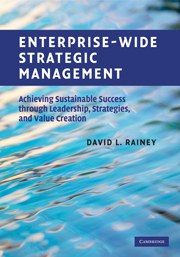 Enterprise-Wide Strategic Management
Enterprise-Wide Strategic Management from Part II - Strategic management: Formulation and implementation
Published online by Cambridge University Press: 05 June 2012
Introduction
Strategic formulation is a complex, vibrant element of the strategic management process. It involves exploring options, determining the mission, selecting objectives, and crafting business strategies and action plans. The leaders of strategic business units (SBUs) discuss, analyze, and objectively consider all of their strategic options as they engage in strategic formulation. This is accomplished in concert with the comprehensive strategic management framework, and based on the results of the strategic analysis as discussed in the previous chapter. The overarching aim is to chart the course for the future and transition and/or transform the business unit into a more successful entity through strategic business planning (SBP), enterprise-wide strategic leadership (ESL), and effective decision making.
SBU leaders often start the strategic formulation by laying out the available strategic options. The question: which ones make the most strategic sense? While strategic leaders often have a good pulse on the realities of their business world, studying and discussing options provide a good segue from the laborious details of strategic analysis to the excitement of strategy formulation. For example, Microsoft, with its numerous strengths, powerful positions, and huge financial resources, has an incredible number of strategic options. It has the resources to become involved in scores of new businesses, new ventures, radical developments, and improvement programs – even acquiring companies outside its traditional business arena. Its effort to acquire Yahoo! for approximately $44 billion is an example of its commitment to improve its position in Internet searches and become a leading player.
To save this book to your Kindle, first ensure no-reply@cambridge.org is added to your Approved Personal Document E-mail List under your Personal Document Settings on the Manage Your Content and Devices page of your Amazon account. Then enter the ‘name’ part of your Kindle email address below. Find out more about saving to your Kindle.
Note you can select to save to either the @free.kindle.com or @kindle.com variations. ‘@free.kindle.com’ emails are free but can only be saved to your device when it is connected to wi-fi. ‘@kindle.com’ emails can be delivered even when you are not connected to wi-fi, but note that service fees apply.
Find out more about the Kindle Personal Document Service.
To save content items to your account, please confirm that you agree to abide by our usage policies. If this is the first time you use this feature, you will be asked to authorise Cambridge Core to connect with your account. Find out more about saving content to Dropbox.
To save content items to your account, please confirm that you agree to abide by our usage policies. If this is the first time you use this feature, you will be asked to authorise Cambridge Core to connect with your account. Find out more about saving content to Google Drive.